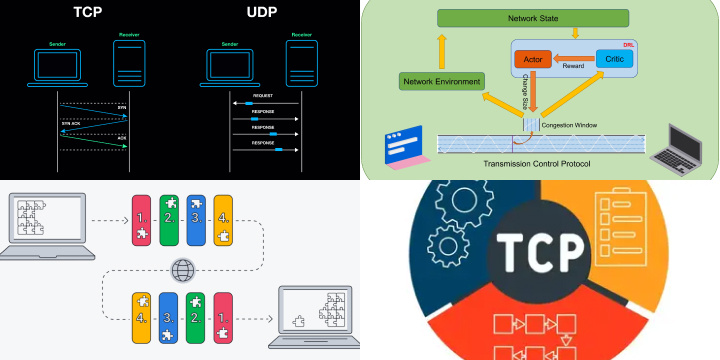Introduction to TCP/IP
TCP/IP stands for Transmission Control Protocol/Internet Protocol, which are two protocols that are used for communication on the Internet. The TCP/IP protocol suite is used by all modern computer networks, including the Internet.
The TCP protocol is responsible for ensuring that data is transmitted reliably between devices. It breaks data into small packets and sends them individually, making sure they arrive at their destination without errors. The IP protocol is responsible for the addressing and routing of data packets across the network.

Together, TCP/IP provides a set of rules for communication between devices on the Internet. It enables data to be transmitted across the network in a way that is reliable, efficient, and secure. TCP/IP is the backbone of the Internet and is used by millions of devices worldwide to communicate with each other. Understanding TCP/IP is essential for anyone who wants to develop or troubleshoot networks and applications that use the Internet.
The Role of TCP and IP in Data Transmission
The TCP/IP protocol suite plays a critical role in data transmission by breaking down data into small packets and ensuring that they are transmitted reliably across the network. TCP is responsible for breaking down data into small packets and ensuring that they are transmitted in the correct order, without errors, and without loss. This is achieved by providing mechanisms for error detection, flow control, and congestion control.
IP is responsible for the addressing and routing of data packets across the network. It assigns unique addresses to each device on the network and determines the most efficient path for data to travel from one device to another.
Together, TCP and IP provide a powerful set of tools for transmitting data reliably and efficiently across the network. By breaking down data into small packets, providing mechanisms for error detection and correction, and efficiently routing data across the network, TCP/IP enables us to communicate and share information with anyone, anywhere in the world.
Understanding the TCP Three-Way Handshake
The TCP Three-Way Handshake is a fundamental process that enables two devices to establish a reliable connection over the internet. It is a process that occurs between the client and server when initiating a TCP/IP connection.

During the Three-Way Handshake, the client sends a SYN (Synchronize) packet to the server, indicating its intent to establish a connection. The server then responds with a SYN-ACK (Synchronize-Acknowledgment) packet, which confirms the client’s request and informs the client that the server is ready to establish a connection. Finally, the client sends an ACK (Acknowledgment) packet to the server, which acknowledges receipt of the SYN-ACK packet and completes the connection establishment process.
Understanding the TCP Three-Way Handshake is crucial for network engineers and administrators, as it forms the basis of all reliable communication over the internet. By grasping the intricacies of the process, they can troubleshoot connection issues, optimize network performance, and ensure secure and reliable data transfer between devices.
Packet Structure in TCP/IP
TCP (Transmission Control Protocol) and IP (Internet Protocol) are two crucial protocols that play a critical role in data transmission over the internet. TCP is responsible for ensuring reliable and orderly delivery of data packets, while IP is responsible for routing packets between devices.
TCP breaks down the data into small packets, assigns a sequence number to each packet, and sends them to the destination device. IP then takes over, ensuring that the packets are routed to the correct destination using the most efficient path available.
Together, TCP and IP work in tandem to enable data transmission over the internet. TCP provides reliability, ensuring that data is transmitted in the correct order and that lost packets are retransmitted, while IP handles routing, ensuring that packets are delivered to the correct destination.
Without TCP and IP, reliable data transmission over the internet would not be possible. These protocols are the foundation of all internet communication and play a critical role in the smooth operation of the internet as we know it today.
Routing and Addressing in TCP/IP
Routing and addressing are key concepts in the TCP/IP protocol suite, which is used to connect devices over the internet. Routing refers to the process of determining the most efficient path for data to travel between devices, while addressing is the method used to identify individual devices on the network.
IP addresses are used to uniquely identify devices on the network, with each device assigned a unique 32-bit address. These addresses are hierarchical and divided into network and host portions. The network portion identifies the network to which the device belongs, while the host portion identifies the individual device on the network.
Routing protocols, such as OSPF (Open Shortest Path First) and BGP (Border Gateway Protocol), are used to determine the best path for data to travel between devices. These protocols use metrics such as distance, bandwidth, and hop count to determine the most efficient path.
Overall, routing and addressing are critical components of the TCP/IP protocol suite, enabling devices to communicate with each other over the internet in a reliable and efficient manner.
TCP/IP Layers and Protocols
TCP/IP (Transmission Control Protocol/Internet Protocol) is the set of networking protocols that enable communication between computers and devices over the internet. It is a layered protocol, meaning that it is organized into distinct layers that work together to facilitate communication.
The TCP/IP model is divided into four layers: the application layer, the transport layer, the internet layer, and the network access layer. Each layer has its own set of protocols that handle specific tasks, such as data formatting, error detection and correction, and network addressing.

The application layer provides services to user applications and is responsible for protocols such as HTTP, SMTP, and FTP. The transport layer handles end-to-end communication and includes protocols such as TCP and UDP. The internet layer routes packets across networks and includes the IP protocol, while the network access layer handles the physical connection to the network and includes protocols such as Ethernet and Wi-Fi.
Understanding the TCP/IP layers and protocols is essential for network administrators, developers, and anyone involved in building or maintaining network infrastructure.
TCP/IP and the Internet
TCP/IP (Transmission Control Protocol/Internet Protocol) is the backbone of the internet, providing the protocols that allow communication between devices across the network. It is a set of protocols that enables the reliable and secure transfer of data between devices, regardless of their location or the type of network they are connected to.
TCP/IP plays a crucial role in the functioning of the internet, allowing devices to communicate with each other by breaking data into packets and routing them through networks to their intended destination. The IP protocol provides the addressing and routing mechanisms, while the TCP protocol ensures reliable delivery by managing data transmission and ensuring data integrity.
Without TCP/IP, the internet as we know it would not exist. It has enabled the growth of e-commerce, social networking, and other online activities that have become a fundamental part of modern society. Understanding TCP/IP and its role in the internet is essential for anyone working in the tech industry or using the internet in their daily lives.
TCP/IP Security and Common Vulnerabilities
TCP/IP (Transmission Control Protocol/Internet Protocol) is a set of protocols that underpins the functioning of the internet. While TCP/IP provides a reliable and secure means of data transfer, it is not immune to security vulnerabilities that can be exploited by attackers.
One common vulnerability in TCP/IP is the use of weak or easily guessable passwords, which can be used to gain unauthorized access to devices and networks. Another vulnerability is the use of outdated or unpatched software, which can be exploited by attackers to gain access to sensitive data or take control of systems.

Denial of Service (DoS) attacks are another common TCP/IP vulnerability, in which attackers flood a network or device with traffic, rendering it unable to function properly. Man-in-the-middle attacks, in which attackers intercept and modify data as it is being transmitted, are also a threat to TCP/IP security.
To mitigate these and other vulnerabilities, it is important to follow best practices for TCP/IP security, such as using strong passwords, keeping software up to date, and using encryption to protect data in transit. Network administrators should also regularly monitor their networks for signs of suspicious activity and implement appropriate security measures to protect against attacks.
Optimizing TCP/IP Performance: Strategies for Efficient Data Transmission
Efficient data transmission is a cornerstone of network performance, and optimizing TCP/IP, the fundamental protocol suite of the internet, is essential for achieving this goal. Several strategies contribute to enhancing the efficiency of data transmission in a TCP/IP environment.
One key strategy involves adjusting the TCP window size. The TCP window size determines the amount of data that can be sent before an acknowledgment is received. By optimizing this parameter based on network conditions, such as latency and bandwidth, it is possible to strike a balance between efficient data flow and minimizing delays.
Utilizing Quality of Service (QoS) mechanisms is another crucial tactic. QoS allows prioritization of certain types of traffic, ensuring that critical data, such as real-time communications or video streaming, receives precedence over less time-sensitive information. This helps in maintaining a consistent and reliable data transmission experience.

Implementing caching and compression techniques further optimizes performance. By reducing the volume of data that needs to be transmitted, these methods minimize the time required for data transfer. Content Delivery Networks (CDNs) also play a vital role, distributing content across multiple servers strategically placed around the globe to decrease latency and enhance data retrieval speed.
Regularly updating and patching network equipment and software is imperative. This ensures that the latest performance improvements and security enhancements are applied, contributing to a well-optimized TCP/IP environment. In combination, these strategies work cohesively to create a network infrastructure that prioritizes efficiency, responsiveness, and a seamless data transmission experience.







